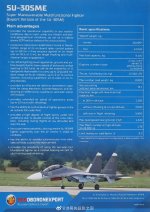Let’s talk about the so-called hybrid electronically scanned radar first.You can't make an apples to apples comparison like that. Although the Bars has less power, it still has 1700+ receivers. So its method of signal processing is similar to that of an AESA
The N011M radar receiving system adopts a design similar to AESA, each unit module has its own LNA low noise amplifier design, which avoids the disadvantage that the loss of the traditional PESA receiving system is 5~6db higher than that of the AESA, but this kind of transmitting system is still PESA's passive structure centralized transmitter,
In fact, the most important thing is the back-end processing system of the radar, the N011M radar. The signal processor of the N011 radar has no programmable technology, and only uses a fixed digital circuit for signal processing. For a fixed digital processor, a corresponding circuit needs to be built for each different waveform to meet the requirements. This directly This leads to a substantial increase in the volume and weight of the equipment, and the programmable digital machine can be configured in real time according to software control, so only a few structural modules can be used to complete a variety of functions, and the volume and weight can be compressed very small. Of course, the most important consequence is that the total weight of the NO11M radar reaches 600KG, while the APG63 is only about 230KG
I don't know the specific situation of India's upgrade. At least the SU30SM exhibited in Russia in 2019 has a target detection range of only 110KM for RCS=3. The NO11M has used Indian computers from the beginning. Until now,I pecially asked at the Russian military forum this point,As for what you said, the target with RCS=5 has 180KM, it is likely to be the staring mode of the radar, and it only searches in a small rangefigure from 15 years ago put the Bars at 185Km vs 5m2 target, so it was as good as entry level AESA radars on smaller fighters like the F-16 today. The 110Km for 3m2 target was using Russian radar computers 20 years ago. With an upgrade to Indian computers in 2007 the range increased to 160Km for 3m2. Since then the Bars radar has had 2 computer upgrades, so we do not know its current range. An AESA upgrade is pending.

I'll call it canard wings for now. This design is derived from SU27M, which is the old su35。The canards provide lift, so it compensates more than enough in performance. As per the Russians, the Su-30SM is only beaten by the Su-35 in WVR combat, so the TVC matters a lot. That's more than enough to showcase its superiority over older Flanker models.
According to the Chinese translation of Russian data, this design is due to the overweight of the N011M radar, which causes the center of gravity of the aircraft to move forward, and the static instability of the aircraft decreases. In order to restore the static instability of the aircraft, a pair of canards are added.
This pair of canards only has a trim effect, and cannot generate eddy currents to increase lift, nor can it be used as the main operating surface to increase maneuverability at high elevation angles, so it cannot be a canard, but a three-wing surface.
With the success of the N035 radar and the advancement of Russian flight control technology, this design was cancelled by the SU35.
As for TVC, this poisonous wine, if you use TVC, your energy will decrease rapidly, which is reflected in the India-US military exercise
As for Russia's military exercises, I think there are two reasons. First, flight control. All Su-27s in Russia are still using vertical analog telex and horizontal mechanical hybrid flight control. Compared with the three-axis and four-degree redundancy of J11B and SU30SM There is a big gap between telex flight control
Second, pure propaganda, after all, is always going to make money.
I don't think there are specific charts and battlefield restorations. It is difficult for us to know the real situation only by the mouth of the pilot.The strongest adversary that we could possibly face in our life as a fighter pilot was the F-16 of PAF (for obvious reasons). So the excitement of facing an F-16, even in a mock combat was unbelievable. The weight of the mission was overbearing! Perhaps that’s what makes it special. As the combat commenced, we manoeuvred for our lives and in very little time the situation was in our favour! The desperate calls from the F-16, “Flare, Flare, Flare!” are very distinctly audible in my ears even today! From that day, the anxiety that prevailed over facing an F-16 in combat was gone forever…. Vanished! It was clear what the outcome would be!”
“Another mission that stand out is a group combat mission that was pitching a Su-30 & one MiG-21 BISON against three F-16 . As luck would have it, the BISON did not get airborne and now the game was one Su-30 vs three F-16 in a BVR scenario. Again, we pushed the envelope, manoeuvred between 3000 ft to 32000 ft, pulling up to 8 g, turning, tumbling, firing and escaping missiles in a simulated engagement. The crew co-ord between us in the cockpit and the fighter controller on the ground was the best that I have ever seen! The results in a mock combat are always contentious but with ACMI, they are more reliable. End score one F-16 claimed without loss. When we got out of the cockpit we were thoroughly drenched in sweat and tired from the continuous high G manoeuvring but all smiles for the ecstasy that we had just experienced.”





